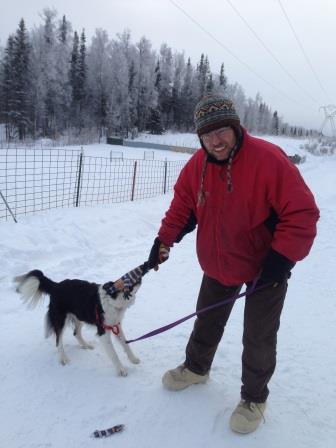
Home > Dispatches > Daily Dispatches 2014 > Daily Dispatch #12
January 12, 2014: Dog Training: Rewards and Toy Drive
I am now attempting to figure out the herding/agility/search and rescue connection, so that I might increase the likelihood of training Ryder to be a good search and rescue dog. I’m still thinking that all the activities we are doing, and this includes ongoing obedience classes and woods walks – are going to work in both our favor. Today we participated in our first agility class – as we did so, another piece of the puzzle fell into place. And, actually, this might be the most essential piece. This is the concept of reward. In agility, a dog must, off leash, traverse ladders, go up ramps, sprint through tunnels, and weave around poles in a set amount of time. They must both focus on their handler, who through his or her body language directs the dog, and take the initiative to move forward and go over the obstacle correctly. For instance, the dog must stop in the proper fashion at the base of the ramp rather than go off the side. |
|
|
Ryder did what she was supposed to do. She didn’t seem to me to be overly enthused about agility – she was alert, and was interested in what the other dogs were doing – but between work sessions she laid down on the small pieces of carpet that had been set out beforehand. She also wasn’t too keen on going through the tunnel. Claudia surmised that perhaps Ryder wasn’t feeling treat motivated. So I, who had stuffed her latest tug toy, Cat Burglar, in my front pocket, gave it to Claudia, who when she came through the tunnel, encouraged her to tug. Ryder then became a bit more animated, and we had a pretty good tug session. So what I learned last week in search and rescue training held true in agility – this was that dogs work for rewards. Ryder is actually learning to learn. She will in time figure out that if she does do as asked, that she will get a hefty paycheck. At first I thought that the concept of reward was fitting for dogs and their rather simplistic mental abilities. Then I realized that we humans do what we do because we too are working for the reward, be it an A in a class or a huge chunk of change. As with dogs, if the pay check is less than expected, then we work less hard or go and find another line of work. I am not sure yet how herding fits into the equation, for it seems to me that reward is not at the end of the tunnel. It could at first be a tuft of wool or a leg of mutton, but it quickly becomes the act of herding. Today’s herding class went well. Pete and Ryder had a good go around – with Ryder being attentive to what Pete asked her to do, which mainly centered around her staying back from the sheep. Heather, who is also in the class, was at one point working with Jill, who rather than stay where she was ordered to stay, instead did an outrun, that is a huge circle around the field, coming back to the far end of the sheep. This is actually a beautiful thing to see, but it wasn’t what Heather wanted. Ryder doesn’t seem to be a dog that is prone to these kinds of flights of fancy – rather, she sticks closer. My turn – the worked sheep were put in one pen, and the fresh sheep were released into the enclosure. So off Ryder and I went. Our sheep did scatter some—Ryder did well at bringing them back. But I had a hard time keeping her on the fence. Suzann finally intervened and showed me how to better use my body and the stick in working with Ryder. Suzann moved in a very fluid fashion – it was mesmerizing to watch. And Ryder relaxed when under her guidance. Quite obviously, I have a great deal to learn about dog behavior and dog/human movements. Well, after, Ryder was barking, so I pulled forth Cat Burglar again. Ryder then engaged in a vigorous game of tug, pulling the arms and legs off Cat Burglar. So, Ryder was rewarded for having done a good job inside the pen. My question is how might she be rewarded inside the pen? There is a website that I need to take a closer look at – it’s an overview of a place in PA where the herders are using positive reinforcement – this including the clicker – in working with the dog inside the pen. For those who are interested in this – here’s the link: www.raspberryridgesheepfarm.com Next: 13. 1/13/13: Dog Training – Search and Rescue training session #5 |
|
